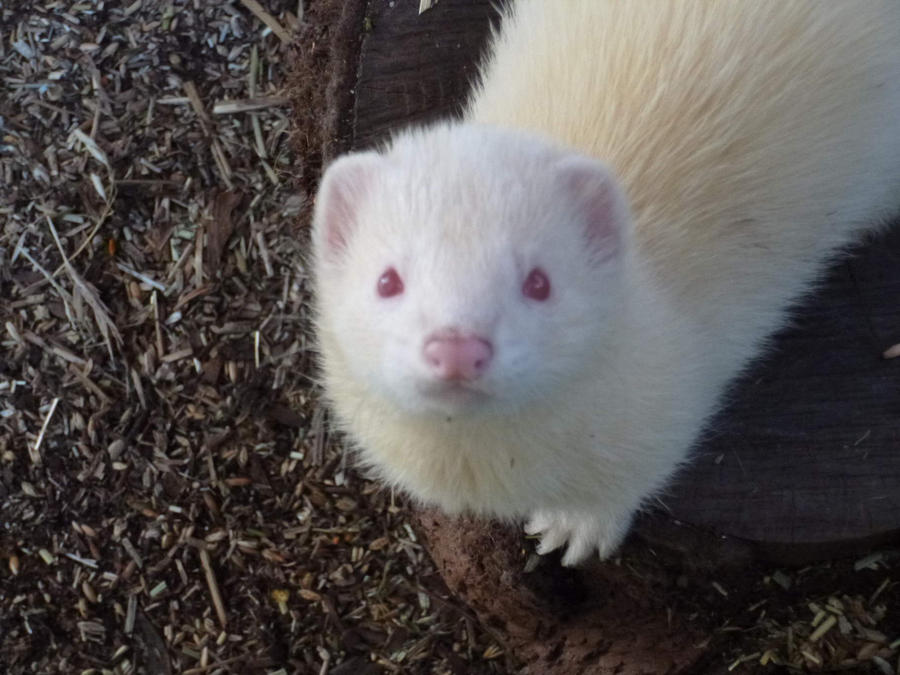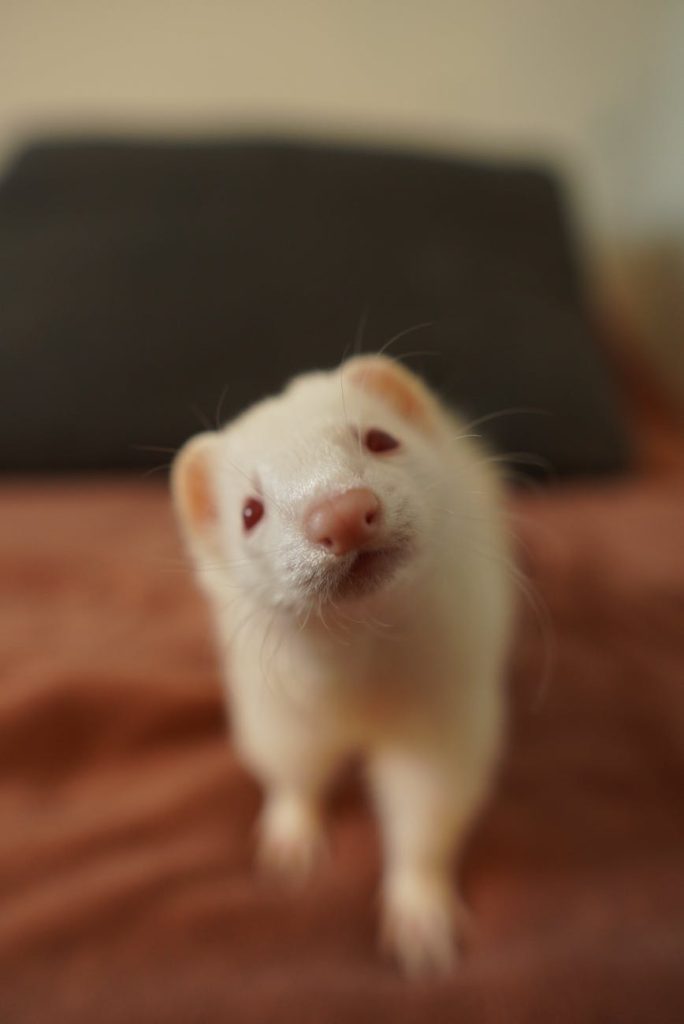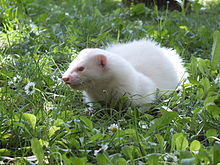Everything You Need to Know About the Albino Ferret
Dr. Abdul Basit Javed (DVM)
The trend of keeping ferrets as pets is growing, and it makes sense given that they are
social, entertaining, and lively animals. They come in different forms and varieties one of
which is “Albino Ferrets”.
Albino ferrets have a white coat with pink eyes, this appearance is due to mutation in their
tyrosinase gene. Due to this mutation, their body cannot produce pigments in their fur,
skin, and eyes. These types of ferrets look unique and beautiful, but this mutation also makes them
prone to some health issues.
If you are interested in albino ferrets and want to know all about them, find out the real
answers from a VET here! Continue reading so I can tell you everything there is to know
about these beautiful playful creatures.

What is an Albino Ferret: Vet Explains
Albino is a variety of ferrets that has white skin and fur along with ruby red eyes.
This white appearance occurs due to the expression of recessive genes. Due to the
expression of recessive genes a mutation occurs in the tyrosinase gene and tyrosinase
cannot be produced by the body.
Due to the absence of tyrosinase, pigment-producing cells known as melanocytes cannot
produce melanin or the pigment that gives color to hair, skin, and eyes. This results in white
hair and skin together with red transparent eyes.
This is how albino ferrets are formed and this condition is lifelong. Ferrets with albinism
are often seen as more attractive than ferrets with other colors since they are rarer and
more distinctive.
What are the Breed Characteristics of Albino Ferrets?
According to AFA (American Ferret Association), ferrets have seven identified color
versions one of which is albino. Ferrets that fit the following standards are
considered true albino by the AFA, and these include the following:
• White to cream-colored undercoat
• White to cream-colored guard hairs or outer coat
• Ruby red eyes
• Pink colored nose
Some ferrets have dark-colored eyes along with white coats but they are not considered
true albinos according to the standards of AFA.
Does an Albino Ferret Change Color as They Grow Old?
Albinism in ferrets is a lifelong condition and it does not change with age and has no cure.
However, the appearance of the fur can change from white to a cream or yellow color
over time. This is due to the staining of the fur when the ferret plays in the soil.
Fur can also get stained due to urine and fecal material if you don’t regularly clean the
enclosure of your ferret. Constant licking of any one area of the body can also result in a
color change in that specific area.
Do Albino Ferrets Exist in the Wild?
Albinism is a genetic defect and can occur in any ferret either domestic or wild although it
is very rare in wild populations of ferrets. It is more common in domestic ferrets because
of the selective breeding done by humans.
This breed of ferret has a lot of disadvantages if they are living in the wild. They cant hunt
properly due to their distinctive appearance and are an easy target for large predators.
They also have poor eyesight and hearing ability. So the survival of an this variety of ferret in the
wild is quite difficult.
Is an Albino Ferret Prone to Certain Conditions or Diseases?
Albinos may look relatively normal (aside from the ferret’s albino red eyes) but they can sometimes have hidden health defects which include the following:
• Poor eyesight
Albinism can lead to poor vision or impaired vision in some ferrets. They can suffer
from either shortsightedness or farsightedness. They can also have a blur vision
due to abnormal development of the cornea.
• Poor hearing
Not all but some albino ferrets can have impaired hearing due to albinism. Albinism
can lead to deafness in some ferrets and this can affect their general behavior.
• Skin problems
Ferrets with albinism are prone to skin infections and problems. Sunburn is also a
major issue for these ferrets. But with proper care and management, you can avoid
these problems and can give your ferret a healthy life.
• Temperament issues
This is not directly related to albinism. The temperament of albino ferrets can be
unpredictable because of their impaired vision and hearing. But this is not the case
with all of them as most of this variety are completely normal.
What is the Temperament of an Albino Ferret?
In general, ferrets are very fun-loving and playful creatures and have a very docile
temperament. However, due to vision and hearing defects, the temperament of some
albino ferrets can become erratic.
Regardless of their temperament albinos make exceptional pets but the owner of
this type of animal has to play his/her part to make the life of their furry fellow easy and
comfortable. With proper care, these fun and wonderful creatures can bring a lot of excitement to their
owner’s life.

What is the Life Expectancy of an Albino Ferret?
Albino ferrets can live up to 8 years even more than that if correctly looked after. Just like
humans, albinism does not affect the life span of a ferret. Make sure you are providing a
good diet and clean water to your ferret for a longer lifespan.
Along with that regular grooming of ferrets and proper sanitation of their enclosure is a
must for their health. Occasional vet checkups are also recommended to rule out the
possibility of any developing disease or condition in your ferret.
What Does an Albino Ferret Eat?
Like other ferrets, albinos should be provided with fresh raw meat. Their diet
should ideally contain 35% protein and 20% fat. Dry food options are available for ferrets
but as a veterinarian, I will recommend feeding them a diet that resembles their natural
food.
You can feed your ferret kitten food if meat is occasionally unavailable or if you can’t find
good-quality meat for them, but don’t continue it for too long. You can feed beef, mutton,
lamb, and chicken to your albino ferrets. They can eat fish but it is not a part of their
natural diet. Never feed them any plant-based protein product.
References:
- Caring for your ferret. (n.d.). Blue Cross. Retrieved August 17, 2022, from https://www.bluecross.org.uk/advice/ferret/caring-for-your-ferret#:%7E:text=Are%20ferrets%20a%20good%20pet,make%20good%20pets%20for%20children.
- Millburn, N. (2020, November 19). Problems With Albino Ferrets. Pets on Mom.Com. Retrieved August 17, 2022, from https://animals.mom.com/problems-albino-ferrets-5093.html
- Murphy, B. J. (n.d.). Ferret News. Ferret World. Retrieved August 17, 2022, from https://www.ferret-world.com/albino-ferrets/








Pingback: A Complete Guide to Ferret Coloring & Patterns (With Chart)